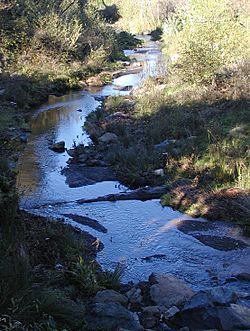San Pedro Creek facts for kids
Quick facts for kids San Pedro Creek |
|
|---|---|

San Pedro Creek, photo of segment of the Capistrano Fish Passage stream bed restoration project.
|
|
| Country | United States |
| State | California |
| Region | San Mateo County |
| Physical characteristics | |
| 2nd source | Confluence of Mid Fork and South Fork 140 ft (43 m) 37°34′47″N 122°28′23″W / 37.57972°N 122.47306°W |
| River mouth | Pacific Ocean Pacifica, California, San Mateo County, United States 26 ft (7.9 m) 37°35′47″N 122°30′21″W / 37.59639°N 122.50583°W |
| Basin features | |
| Tributaries |
|
San Pedro Creek is a stream in Pacifica, California. Its name means St. Peter in Spanish. This creek flows all year round. Its waters come from Sweeney Ridge and Montara Mountain. These mountains are part of the Santa Cruz Mountains.
The main part of the creek is about 2.5 miles (4 km) long. It flows through the San Pedro Valley. Finally, it reaches the Pacific Ocean near Shelter Cove. San Pedro Creek is famous for a historical event. In 1769, explorer Gaspar de Portolà camped here. After that, he climbed Sweeney Ridge and discovered San Francisco Bay.
Long ago, the south fork of San Pedro Creek was a trout farm. A man named John Gay ran it. But in 1962, big storms washed away the whole farm. Today, the south fork provides water for Pacifica during the wet season. San Pedro Creek is also special because it's a home for steelhead trout. These fish can grow up to two feet long. It's the only major steelhead habitat for 25 miles (40 km) between San Francisco and Half Moon Bay.
Contents
San Pedro Creek: A Home for Wildlife
The San Pedro Creek area is full of life. Many different plants and animals live here. The cool, clear water of the creek helps them survive. Fog also plays a big role. It provides a lot of moisture. This moisture helps the creek's forks flow all year.
Plants and Trees of the Valley
The mountains around San Pedro Creek are not covered in tall redwood trees. Instead, you'll find a unique type of landscape. It's called the "Franciscan Landscape." This area has many coastal shrubs. One common plant is Coyote Brush. You can also find special plants here that grow nowhere else.
Some unique plants include:
- Giant Golden Chinaquapin
- Montara Manzanita
- Fetid Adders-tongue
- California Hazelnut
These plants often grow near shrubs and sword ferns. Fetid adder's tongue is very common. It has mottled green leaves and brown-purple striped flowers. It also has a strange smell, like rotting meat.
In the middle and lower parts of the creek, you'll see other plants. These include Creek Dogwood, Arroyo Willow, and Watercress. Many types of ferns also grow here. In spring, the meadows burst with wildflowers. You can spot California Poppies, Suncups, Buttercups, Wild Radish, and Wild Mustard.
Animals Living Near the Creek
Many animals live in the San Pedro Valley. You might see some of them often.
- Red-tailed Hawks
- Turkey Vultures
- Quail
- Scrub Jays
- Garter Snakes
Other animals are shyer and harder to spot.
- Deer
- Bobcats
- Grey Fox
- Raccoons
- Rabbits
- Gopher Snakes
The three forks of San Pedro Creek are very important for steelhead trout. These fish come here to lay their eggs. This is called spawning. The steelhead spawning season is usually from December to February.
Protecting San Pedro Creek
In 1999, some people from Pacifica formed a group. It's called the San Pedro Creek Watershed Coalition. Their goal is to keep the creek and its watershed healthy. They do many things to help.
- They watch the creek for problems.
- They work to fix damaged areas.
- They teach people about the creek.
This group works with the Environmental Protection Agency (EPA). They track pollution sources in the creek. A study in 2000 looked at the creek's water quality. It found high levels of certain bacteria. These bacteria levels were too high for safe recreation. This is why beaches near the creek's mouth sometimes close.
Pollution levels were highest during the rainy season. This happened when a lot of water ran off the land. The main source of pollution was from birds. But dogs, humans, horses, raccoons, and deer also contributed. During the dry season, raccoons and dogs became bigger sources of pollution.
Making the Creek Better: Restoration Projects
People have worked hard to improve San Pedro Creek. They want to protect it and prevent flooding.
Helping Fish Travel Upstream
In 2005, the City of Pacifica finished a project. It was called the Capistrano Fish Passage restoration. They fixed about 1300 feet (396 meters) of the streambed. They also improved the Capistrano Bridge culvert. A culvert is like a tunnel for water under a road. These changes helped young fish. Now, they can travel upstream through this part of the creek more easily.
Controlling Floods in the Valley
San Pedro Creek has had big floods in the past. Major floods happened in 1962, 1972, and 1982. To prevent future damage, the City of Pacifica started a big project. It was a five-year plan that cost five million dollars. They rebuilt the lower part of San Pedro Creek. This project finished in May 2005.
This flood control project was a huge success. It also worked with improvements to the nearby Pacifica State Beach. Because of this, the project won a top national award in 2005. It was from the American Shore and Beach Preservation Association.

